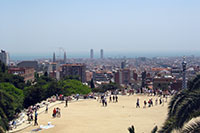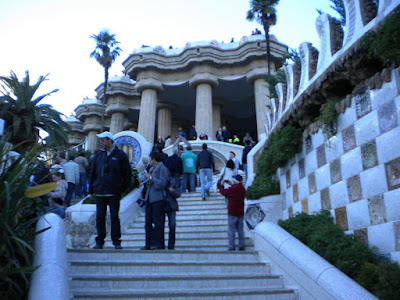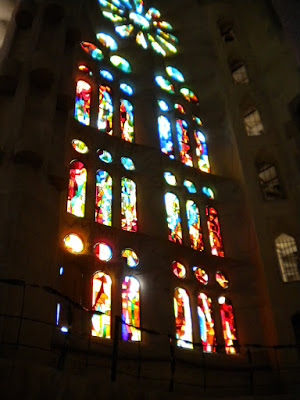MONDAY, November 8, 2010
We began this trip on Monday, Nov. 8, 2010, departing Gilmer about 8 a.m., leaving Isabella at the kennel in Longview and then driving to the Houston Intercontinental Airport. We arrived at the airport at about 2 p.m. for our flight that departed at 4:35 p.m. When we checked in at the airport we were told that our flight would be departing 2-3 hours later than scheduled. That pushed our arrival time at London Heathrow to about 9:00 a.m. the next day so that it became necessary to reschedule our connecting flight to Barcelona to a departure of about noon. With all those details attended to we sat down to wait and finally did depart from Houston at about 7 p.m. that evening.
TUESDAY, November 9, 2010 (Barcelona, Spain)
The overnight flight (9 hours) to Heathrow, London, was pleasant with lots of empty seats so there was plenty of room to relax if one can relax in a confined area traveling at 625 miles per hour. Outside in England it was cold and rainy when we arrived the next morning and we were glad that we had our coats with our carry-on luggage. At Heathrow the transfer from the international terminal to the domestic terminal for our flight to Barcelona required us to walk for 15-20 minutes before we finally arrived at a gate where, after our documents were checked, we boarded a bus. This bus, much like a subway car with very few seats and lots of places to stand and “hang on”, took us on a 20-30 minute ride that finally ended on the runway where our plane was parked. We exited the bus and climbed the stairs to board the plane.
The 2-hour flight to Barcelona was crowded. With the time change of one hour forward we arrived in Barcelona about 2:45 p.m. We had pre-arranged our transfer from the airport to our hotel but did not readily locate our driver. After asking a number of people, most whose English we didn’t understand, we eventually located the office for our transportation and within a half hour we began our ride to the hotel.
I had booked a small hotel named “Evenia Rossello” that was located near the Las Ramblas area of Barcelona. Once into our room we found a couple of confusing items. The bathroom was equipped with a bidet which we didn’t know how to use so we just looked it over and then ignored it for the rest of the stay. The other item was the room safe. We finally located it in the closet but it was missing the lock as if it had been “drilled” or never fitted with a lock. When I inquired about it at the hotel desk I was told that a 20 Euro deposit was needed for a lock. So, I handed over the deposit and obtained the lock even though I wasn’t very comfortable with that situation. We did use the safe for some of our items, but did not trust it with everything of value we were carrying.
We had made plans with various members of Cruise Critic to use private tour operators while on the cruise. Because these private tour operators had all requested to be paid in cash, Euros for all tours except the one in Turkey where we paid with US dollars, I had traveled with lots of cash in a money belt. I continued to wear this money belt until we were onboard the ship and were then able to access the stateroom safe on the ship which I was more comfortable using.
Once settled in the hotel in Barcelona we decided to explore the area around the hotel and departed at about 4:30 p.m. planning to walk some and eventually locate a restaurant where we might eat dinner before we returned to the hotel. Or, if we did not locate such a restaurant, we thought we might return to the hotel about 6 p.m. for dinner in the hotel restaurant. We walked for perhaps an hour or so through a very nice area with multiple story buildings that appeared to have small shops on the ground floors and residences on the floors above. Among these small ground-floor shops were a number of bakeries with lots of delicious looking baked items on display. It soon became apparent that these bakeries were also neighborhood restaurants offering a array of nice “light” meals in addition to the wonderful desserts. So, one of those delightful places with small meat entrees and wonderful desserts of chocolate along with lemon and raspberry flavored tarts, was our choice for dinner that evening.
We returned to the hotel to find that, had we wanted to eat in the hotel restaurant, we would had to wait a few hours. The restaurant was open for breakfast and lunch 8 a.m.-2p.m. Then it closed and didn’t reopen for dinner until 9 p.m. The next day we noticed that those were the standard hours for most of the restaurants of the city.
WEDNESDAY, November 10, 2010 (Barcelona, Spain)
The next morning we departed the hotel at about 8 a.m. allowing time for breakfast at another of the nice neighborhood bakeries and the walk of about 10 blocks to the downtown area of Barcelona to the office of Julia Travel where we were to depart for our tours of the day.
Here is a street scene in the downtown are of Barcelona. At 9:45 a.m. we departed for our tour, “Classic Barcelona”, a 3 1/2 hour trip that was billed as a “sightseeing tour plus Spanish Village”. We had an excellent guide who presented the tour in both English and Spanish. First the English information was given about a stop, then it was followed by the same information in Spanish (I think).
Here is another street scene as we traveled (taken through the window of the bus).
Our first stop was in the Gothic quarter at the Basilica de Santa Maria del Pi with its bare Catalan Gothic exterior. This basilica owes its name (pi means pine) to the pine forest that once stood here and spanned from the walls of the Roman city to the Ramblas. In 1322, work began on the basilica building, which is in typical Barcelona Gothic style, although the main entrance is Romanesque. It is an imposing structure with a 178 ft. tower. There is also a rosette window, truly impressive for its size and the lighting created by the sun at the different times of the day.
Another side of the same cathedral.
The foundation of the city of Barcelona is subject of two different legends. The first attributes the founding of the city to the mythological Hercules 400 years before the building of Rome. The second legend attributes the foundation of the city directly to the historical Carthaginian Hamilcar Barca, father of Hannibal, who named the city “Barcino” after his family, in the 3rd century BC.
Column of the Barcino Temple still standing in the area. Parts of Roman walls have been used in the buildings constructed at a later time.
Some of the beautifully decorated buildings in the area.
Bridge of Sighs — "Eternal Love"
We walked under the medieval Bridge of Sighs--a copy of the one in Venice--located in the streets of the Gothic Quarter.
A short walk brought us to entrance of the Barcelona Cathedral or Cathedral Le Seu. The elevated site occupied by this cathedral has always been the spiritual center of Barcelona. First there was a Roman temple here, then a mosque, and then a church. Construction on the present cathedral began in 1298 and was completed in 1448. Barcelona Cathedral is a celebrated example of Catalan Gothic architecture dating from the 14th century. Its graceful spires can be seen from throughout the Gothic quarter of Barcelona.
Inside one sees the beautiful Cloisters of this cathedral.
And the gaggle of white geese whose ancestors have lived here for five centuries. How they originally came to be here remains a mystery and they are certainly an unusual feature for a cathedral. Various legends have it that they represent the virginity of St. Eulalia or the former splendor of Rome.
Leaving the Gothic quarter we traveled through a modern city with it tropical palms and statutes.
We climbed above the city on Montjuic Mountain where we could look down on the vast expansion of the city of 1.6 million people.
And arrived at the Spanish Village. Here is the clock tower “Torre de Utebo” in the Spanish Village.
The Spanish Village was built for the 1929 International Exhibition in Barcelona on the Montiuic hill. Its aim was to show visitors a representative sample of Spanish architecture. A team of two architects, an engineer and an artist created the Spanish Village by erecting 116 buildings in different architectural styles representing Spain's many regions. The village features a large square, the Plaza Mayor, and a couple smaller squares connected by picturesque streets, some with stairs. It includes a town hall, a church, a monastery, shops and residential buildings.
The city wall of the Spanish Village.
Scenes inside the Spanish Village.
Showing the different styles of architecture.
Our tour, back at the Julia Travel company, ended at approximately 1:45 p.m. and we proceeded to a restaurant, Cent Focs, recommended by people in the travel company. It was an excellent choice. I had the 3 course special of the day which was a very nice salad, followed by a pot roast entrée, and then a delicious dessert. Sylvia had Cannelloni and we shared my dessert. It was a very nice, but heavy, meal, appropriate to be followed by a nap. That didn’t happen for us; too far back to the hotel for the time we had. So, we walked through the Las Ramblas area, enjoying the sights.
Even though these look like statutes they actually are living, breathing people posed, called mimes.
Our next tour, Artistic Barcelona, began at 3:30 p.m. and ended shortly after 7 p.m. Again, we departed from the area of the Julia Travel in downtown Barcelona and traveled through the city.
Our first stop was at Park Guell where Antonio Gaudi lived in the early 1920’s. This park was commissioned by Eusebi Güell who wanted to create a stylish park for Barcelona aristocracy. The park contains amazing stone structures, stunning tiling, and fascinating buildings.
Here you can see a walkway supported by twisting rock pillars that seem to be growing out of the ground like tree trunks. Although these are rather irregular in shape they do feel strangely natural too. Gaudi was strongly influenced by natural shapes and used them in his work.
Inside Park Guell is a small house which Gaudi lived in at one stage. The house has now been converted into a museum and contains interesting furniture also designed by Gaudi.
Additional creations by Gaudi that appear to be growing from the earth.
Here, with the lovely blooms in the background we posed for the camera…
Other views of this park of Gaudi’s creations and people…
Village created by Gaudi
Ascending the staircase which is also designed by Gaudí, one sees the dragon-like lizard which is the best known symbol of the park.
The Grand Plaza Circular was designed by Gaudi as a marketplace. The view from the plaza is spectacular, you can see as far as the Mediterranean Sea.

Seen below are some of the 86 huge columns supporting the platform and creating a hall beneath the plaza, known as the Sala Hipòstila.
The decorated ceiling of the hall below the plaza.
The staircase leading to the huge supporting columns with the plaza above…
Interesting roof of a house in the Gaudi village…
“Learning” columns in stone in the park…
Leaving the Gaudi park and village area we traveled to the Sagrada Familia which was our final stop for this tour.
Here is the area referred to as the Façade of the Nativity. Sagrada Família, is a large Roman Catholic church designed by Catalan architect Antonio Gaudi. Although incomplete, the church is a UNESCO World Heritage Site, and shortly before our visit here was consecrated and proclaimed a minor basilica by Pope Benedict XVI.
Though construction of Sagrada Familia had commenced in 1882, , Gaudi took over in 1883, transforming the project with his architectural and engineering style — combining Gothic and curvilinear, Art Nouveau forms with ambitious structural columns and arches.
Gaudi devoted his last years to the project and at the time of his death in 1926, less than a quarter of the project was complete. Sagrada Familia's construction progressed slowly as it relied on private donations and was interrupted by the Spanish Civil War only to resume intermittent progress in the 1950s. Construction passed the mid-point in 2010 with some of the project's greatest challenges remaining and an anticipated completion date of 2026 — the centennial of Gaudí's death.
This second of our tours for the day ended at approximately 7 p.m. and we walked the 10 or so blocks back to our hotel, stopping along the way at another neighborhood bakery for a delicious light dinner.
THURSDAY, November 11, 2010 (Barcelona, Spain)
The ending of our tour yesterday with an outside view of the Sagrada Familia left us wanting to see more. Since this was our scheduled day to board the ship and our check-out time for the hotel was 12 noon, we decided that we might make another trip to the Sagrada Familia. I inquired at the hotel front desk about the possibility of our walking to this lovely unfinished church so that we might be able to visit the interior but was advised that it would be better if we used the subway. So, we departed about 8 a.m. walking the 2-3 blocks to the closest subway station. Once inside we could not locate any information in English about the stops, fares, or directions for using the machines that held the subway passes. After about 10 minutes we decided to continue on with our first impulse and walk to the site. We did find it was a “healthy” walk--I think about 3 miles each way with multiple crossings of very busy streets—but there were crosswalks with lights. We made the trip in less than an hour and began our tour inside the Sagrada Familia. It was certainly worth the walk!
Again, the self-guided tour was well worth the walk and the time spent. We ended this very enjoyable tour about 10:30 a.m. leaving enough time to walk back to our hotel and not be late checking out at 12 noon.
A 20-minute cab ride took us to the cruise port where we boarded Royal Caribbean’s Brilliance of the Seas. Check-in was fairly easy and the lines were not too long. The most memorable event of the check in process was that they ship took possession of our passports. We learned that this was so that the passports could be examined by the Turkish authorities prior to our arrival at the port for the Ephesus, Turkey stop.
We always carry multiple photo copies of our passports. When we were in Russia we had to give a copy to the Russian authorities each morning that we were there. We’ve only had to turn in our passports on one other cruise. When we were sailing from Australia to New Zealand we had to take them to the ship’s customer service desk and turn them in before sailing into New Zealand’s waters. In both that situation and the one on this cruise, the passports were returned to us in a few days.













































































No comments:
Post a Comment